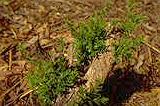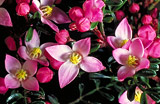|
[Front Page] [Features] [Departments] [SGAP Home Page] [Subscribe]

Electronic Mailbox

The following have been selected from the questions received on the SGAP World Wide web site over the past few months and from contributions directed to the Electronic Mailbox specifically. You're welcome to comment on any issue concerning Australian native plants....growing, propagating or appreciating...anything.

A Real Turn-up!
Iím seeking information on Banksia pods which we wood turners here in the USA use to make ornamental vases and such. I understand now that the Banksia tree is native to your area. Can you tell me which species of pod it is we use for turning? They are about 6-10 inches (150-250 mm) long, two inches (50 mm) around with fuzz along the out side and funny serrated oblong protrusions. It sound like the Banksia serrata you have described on your web page on banksias. Is that it? Can you tell me some one I may contact about about purchasing some of these? They are quite hard to get here. Any info you can give me will be most appreciated.
Dennis Stanworth,
USA
It's interesting that you are working with banksia cones there. Using the cones to make ornamental vases and other wooden objects is fairly common practice here but I never thought that it would be done overseas.
I'm afraid trying to identify the species from your description is just about impossible. It could be a number of things. B.serrata is possible but it's pod is wider than 50 mm and has large protruding seed follicles. If I had to guess I would say B.ericifolia. It's pod is about the right size and it is probably one of the most commonly grown.
As to getting hold of some....the only suggestion I can make are the commercial seed suppliers. They must collect thousands of pods but, what they do with them I don't know. Perhaps they sell them to local wood turners or perhaps they burn them.

A Reluctant Bottlebrush
I have a 15 year old bottle brush in the front garden of my St Kilda home, and for a couple of years it has not produced any flowers. I wonder whether there is any advice you could give me - fertiliser or soil additives, or pruning.
Otherwise, the dear thing may have to go...
John Little,
St Kilda, Australia
Surely not!!!
There could be a few reasons for a recalcitrant bottlebrush (Callistemon spp), but the two that spring to mind are fertiliser and water. I'm not too sure about the weather down there but if the last couple of seasons have had less than average rainfall, this could cause the plant to shut down. Callistemons like lots of water and occur in moist locations in nature.
If the plant hasn't been fertilised for some time it could have depleted the nutrient supply. Unlike some other Australian plants, Callistemons don't mind fertilisers which is why they often grow quite well in a fertilised and watered lawn. An application of a complete fertiliser now might be worth a try (at the recommended rate).

This Callistemon, is showing vigorous regrowth after being cut back to within 300mm of the ground. Select the thumbnail image or plant name for a higher resolution image (45k).
If neither of these reasons seem to fit your conditions, a drastic method would be to cut it back very heavily to try to rejuvenate it. In my experience Callistemons can tolerate cutting back to near ground level and will quickly send out new shoots (there is always some risk with this so no guarantees! but I'd be very surprised if the plant didn't recover). You'll lose one or two seasons flowers by doing this. If you decide to prune, it would be best done soon so that new growth is hardened off before winter.

....and Recalcitrant Boronias
I have collected some Boronia seeds and I would like to know how to treat them so that they will germinate properly. They all come from a healthy parent plant so I believe that they will grow up well except that I am unsure of how to treat them.
Jeremy de Korte,
Australia
I'm afraid that propagation may not be easy. Boronia and some of its close relatives (eg Eriostemon) have not proven to be easy to grow from seed. There are some exceptions; some of the Western Australian species have been successful but, generally, all Boronias are propagated from cuttings.

Boronia microphylla, is a beautiful small shrub but, like its relatives, is difficult to grow from seed. Select the thumbnail image or plant name for a higher resolution image (29k).
The following advice from "The Encyclopaedia of Australian Plants" may help:
"Many of the western species are easily grown from seed, whereas species from the eastern states have proven much more difficult. Pre-sowing treatment of soaking seed in boiling water for 12-24 hours has proven beneficial for some species. Immersion in running water for 1-4 weeks has also been of benefit."
There was also a feature article on cultivating and propagating Boronia in the December 1996 issue of "Australian Plants online".
If I was sowing the seed, I'd give half the boiling water treatment and half no treatment and hope for the best. Germination could be slow, if it occurs, so I'd be prepared to wait for several months.

Germinating Lobelia
I hope to begin several greenhouse experiments using Lobelia alata (the angled lobelia) and possibly other native Australian Lobelia species, with seed collected from wild populations. I am wondering if anyone at SGAP might be familiar with germination requirements for Lobelia seeds, or have any other experience growing these species. If anyone can give me any information or any benefit from their own experience, I would be very grateful.
Martin Burd,
Monash University, Melbourne
This one beats me, but I asked our resident authority,John Wrigley, to comment and he replied:
Lobelia seed is very small but germinates readily without treatment, after storage. The seed has an in-built dormancy which is easily overcome by storage prior to sowing. When ripe the dried capsules release seed quickly and it is worthwhile
to tie a paper bag over the flowering stem when close to maturity, to ensure that the seed does not escape. Store the ripe seed in the dark for about 2 months, then sow in a normal seed growing mix. Cover the seed very lightly and ensure that the mixture is kept damp. Germination proceeds in 7-14 days. Some species are difficult to grow on as it is believed that the plants have a mycorrhizal association with a fungus. This does not appear to be the case with L.alata as it is readily cultivated.

Plants for Reptiles
I own a red phase bearded dragon and am interested in creating a terrarium containing plants from its natural habitat. They are distributed across Australia from the central deserts all the way to the woodlands of the eastern coast. The temperature in the terrarium would be between 80-95 degrees F and it would be lit with full spectrum fluorescent lights. It is a double level setup with 18 inches from the soil to the lights, and with a large section of the tank that has three feet of space from bottom to the top. Basically I'm looking for rugged, non poisonous, sturdy plants that can grow under these conditions. Any help or suggestions would be greatly appreciated.
Daniel Littrell,
California, USA
I am no longer surprised by the questions we receive......
I decided to "duck" this one as well. John Wrigley suggested the following:
At these high temperatures your choice of plants is limited. However the following native species would probably withstand the heat and do well. Triodia scariosa, T. basedowii, T. mitchellii, Scaevola spinescens, Sida petrophila, Swainsona galegifolia, Atriplex holocarpa, Rhagodia spinescens and Enchylaena tomentosa.

Norfolk Island Pine
I just purchased a "Norfolk Pine." Since I live in Colorado, United States and we have severe winters, I was wondering if this Norfolk Pine can survive outdoors as our pine trees in Colorado do. It appears to be more of a fern than any pines that I am familiar with, so I would guess that it is strictly a house plant. Your response to this question would be most appreciated.
David Swope,
Colorado, USA
The Norfolk Island Pine (Araucaria heterophylla) is a native of Norfolk Island, a small dot in the ocean several hundred kilometres off the eastern Australian coast. Norfolk Island is part of Australia, administratively.
The climate on the island is fairly mild and winters would certainly not be severe in your terms. The plants are able to tolerate severe coastal conditions and are widely used as beachfront plantings in sub tropical and temperate areas of Australia. It can tolerate moderate frosts (down to say minus 5 - 8 degrees C) but whether it can cope with greater severity, I can't say and none of my references are helpful on this.
I hope this is of some help.

Growing Counterclockwise
I'm writing for a landscaper in Kentucky, USA. He found what the owner said was an Australian vine. It grows counterclockwise, vines extensively with insignificant spring flowers. Any idea? We thought it
might be an Australian grape vine for wine. Any information would be appreciated.
J Clifford,
USA
 I'm afraid I'm not going to be a great help with this. It could be any number of things.
I'm afraid I'm not going to be a great help with this. It could be any number of things.
"Native Grapes" in Australia are in the genera Cissus, Cayratia and Tetrastigma. These are all in the grape family, generally have small flowers and produce grape-like fruit which are edible but not particularly palatable. I suppose wine could be made from them but the flavour would probably be ...er, different.
I can find no reference to "counterclockwise" growth - perhaps it grows clockwise here in the southern hemisphere :-)
Your best bet would be to send a pressed specimen of flowers and leaves to a botanic gardens in your area. In Aus, the Botanic Gardens offer an identification service and I suppose the same would apply there.
Sorry I can't be of more help

Propagating Grass Trees
Here's a question for the magazine. I would like to grow grass trees from seed. I currently have Xanthorrhoea minor (?) seeds but I'm not fussy about which particular one I grow. Which would be easiest? When should I put them in and is there any special treatment I should carry out?
Alison Payne,
Melbourne, Australia
Xanthorrhoea species may be slow to germinate from seed and it is sometimes suggested that the seeds be rubbed between two species of sandpaper before sowing to help moisture to penetrate. You may have to wait up to 12 months but, hopefully some results will be seen within a couple of months.
I'm not aware that any species is particularly easier to germinate than any other so I would try species that are likely to grow in your district, ie preferably a local species.
X.minor is one that I have grown from seed (many years ago). It's a good small plant but, like all xanthorrhoeas, it's very slow growing.

Snottygobble?
Can you please help? I have been trying to grow Snottygobble (Persoonia longifolia) from seed. I have tried recreating a bushfire situation, thinking that smoke may be a trigger. I have also tried soaking fruits to thoroughly remove flesh before bushfire treatment. Seeds still appear to be viable in seed trays so I am still hoping!!! Have you any suggestions as to other techniques to try?
John Eyres,
Western Australia
Snottygobble? I'm glad you mentioned the botanical name or I really would have been in trouble. I've never heard that one before...perhaps it's a name only used in the west.
Unfortunately I'm not going to be much help. Persoonias are well known as being almost impossible to grow from either seed or cuttings. Some people have reported some success by raking the fruit into a heap below the plant and leaving them there. Some germination reportedly occurs but it can take a long time (a year or more).
I haven't heard of smoke treatment being applied to Persoonia but it is undoubtedly worth a try.
I can only suggest that you don't throw the seed trays out in disgust - even if your treatments are successful it could still be a long time before germination occurs.
If you have any success, I'd appreciate hearing about it.

Growing in Alkaline Soils
As a new reader I've noticed several questions relating to lime-tolerance of plants, and others on propagation. We have a native plant nursery at Morgan, in South Australia's Riverland (River Murray). Our soils are all either alkaline sand, alkaline rock or floodplain clay so we've some knowledge of what will grow in each situation and would be happy to correspond directly. Our snail-mail address is Box 74, Morgan, S.A. 5320 and our e-mail is: atriplex@riverland.net.au. We can also send out a descriptive catalogue and would love to meet anyone who might be planning a visit to these parts.
Anne Green,
Morgan, South Australia
Thanks for that, Anne. Questions regarding plants suitable for alkaline soils are difficult for me to answer because my experience is in east coast, slightly acid soils. I hope a few readers will take you up on the offer.

Any Eucalypt Contacts?
When it comes to suggestions of topics for the magazine, all I can say is more trees...especially eucalypts!
Do you happen to know any eucalypt growers and collectors collectors who'd like to correspond with an American via e-mail and maybe answer questions about the trees?
My mother lives in San Diego, southern California. When I visit her I enjoy the landscape so much. In addition to the mountains, desert and ocean, about 80% of all trees are eucs. It's is so beautiful and I love the fresh smell of the eucalypt oil in the air. Almost magical.
Rick Blauman,
RMBLAUMAN@aol.com
Well, we'll do our best to oblige!. If any eucalypt enthusiasts would like to get in touch with Rick, he'll be very pleased.
 [Front Page] [Features] [Departments] [SGAP Home Page] [Subscribe]
[Front Page] [Features] [Departments] [SGAP Home Page] [Subscribe]
Australian Plants online - March 1997
The Society for Growing Australian Plants
|